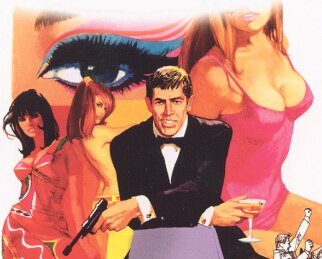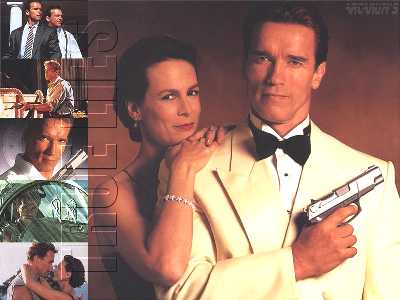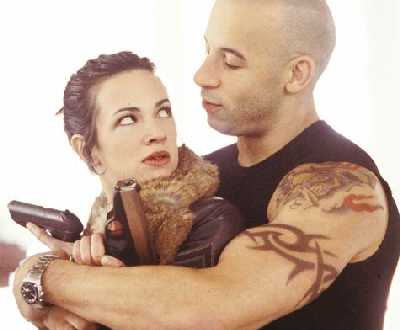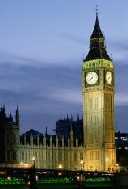|
Nobody
Does It Better?

As
the restrictions on sex and violence began to loosen, the James Bond
series gave sixties audiences an irresistible cocktail of glamour,
exotic locales, humour, suspense, stunts and scantily clad women. The
formula, perfectly encapsulated by Goldfinger in 1963, placed a suave
man of action against various eccentric, colourful villains. The modern
action film was born and espionage became a common theme in cinema. To
be inspired by or borrow from things that may have been inspired
elsewhere is common and in the action/adventure genre all things lead
back to 007. Look at the trailer for the upcoming Clive Owen action
film Shoot Em Up. As the trailer ends the numbers '007' rather cheekily
appear on the screen and linger for a moment before turning into 2007.
Indiana Jones, Arnie, Derek Flint et al owe a major debt to Bond, James
Bond. Or perhaps Broccoli, Cubby Broccoli. The ultimate goal
of
the modern action hero was to have a Bond style series of his or her
own. Of course there were spy and adventure pictures before 007 and
Bondish precursors like North By Northwest but the James Bond franchise
took the elements into the modern age and spawned countless imitators.
During the"spy craze" period of the mid-1960s it seemed that nearly
every show borrowed elements from the James Bond series.
Espionage-themed television programmes included I Spy, Mission
Impossible, The Man From U.N.C.L.E., Get Smart, and Danger Man. Shows
like the Prisoner and The Avengers incorporated a fantasy element into
the mix. Roger Moore starred as Simon Templar, master of disguise and
star of The Saint and Ian Ogilvy later also filled the role on TV in
the seventies. The recent Val Kilmer effort, which was planned as a
series, is best forgotten. Although not a spy in the strictest sense of
the word, Templar is an enigmatic figure, living under assumed names
and with a shady history - his services can be bought and sold, he is
against violence, and he can assume any identity. Roger Moore's eyebrow
raising charm in the role kept him in the 007 sweepstakes long enough
to nab the role in the early seventies.
The Manchurian Candidate was a 1959 thriller novel written by Richard
Condon, later adapted into films in 1962 and 2004. The first and best
of these starred starred Frank Sinatra, Laurence Harvey,
Angela
Lansbury and Janet Leigh. Raymond Shaw is perhaps the most effective
type of spy - an agent who doesn't realise that he is working at all,
having been programmed by the Government to carry out their bidding
without doing so. A big-screen counterpoint to the 007 series featured
Michael Caine as the bespectacled, world-weary, cornflake munching
Harry Palmer; developed for the screen by Bond producer Harry Saltzman.
Palmer was devised by Len Deighton in his series of novels. He got a
series of sorts with The Ipcress File, Funeral in Berlin and Billion
Dollar Brain. Stylish and well-made, with distinctive music, the films
are well worth seeking out if you haven't seen all of them. An American
version of 'Harry Palmer' with a Harold Pinter screenplay from the
first of Adam Hall's many Quiller novels - was Quiller, an agent
(George Segal) called upon by Alec Guinness to infiltrate the neo-Nazis
(led by Max von Sydow) in post-war Berlin, in The Quiller Memorandum
(1966).
Would be Bonds of the sixties included Matt Helm and Derek Flint. Helm
starred in thirty novels by Donald Hamilton and the government
operative got to the big screen when Columbia pictures decided to jump
onto the Bond craze. In a move that probably didn't please all Helm
fans, the pictures were spoofs with a slightly sozzled looking Dean
Martin lending his laid-back style to proceedings. The Silencers
(1966), Murderer's Row (1966), The Ambushers (1967), and The Wrecking
Crew (1968) are sporadically entertaining but laissez faire with the
source material.
Our Man Flint, a 1966 film directed by Daniel Mann attempted to create
a character who could beat Bond at his own game. Tongue in cheek and
witty, Flint, like 007 armed with a neverending array of arcane
knowledge, battled nefarious world threatening organisations with
exotic gadgetry while finding time for numerous beautiful women. James
Coburn brought his toothy charisma to the part. The film was well
received but 1967's In Like Flint seemed to stretch the joke a bit too
far. Derek Flint was more or less done although he, perhaps as much as
Bond, inspired Mike Myers one-joke Austin Powers series. Ray Danton
later played Flint in a 1976 television pilot.

A secret agent named Hubert Bonnisseur de la Bath alias O.S.S. 117, was
created by French thriller novelist Jean de Bruce; the character was a
wealthy Louisiana gentleman who spied for the American OSS, and was
found in a number of films (pre- and post-Bond) popular with European
audiences: OSS 117 Is Not Dead (1956, Fr) (aka OSS 117 N'Est Pas Mort),
O.S.S. 117: Double Agent (1967) and No Roses For OSS 117 (1968, Fr)
(aka Pas De Roses Pour OSS 117) - both with John Gavin as the agent.
John Gavin of course almost become James Bond at a later date. 2006 saw
the release of OSS 117: Cairo, Nest of Spies (OSS 117: Le Caire nid
d'espions), a spoof of the earlier series and Bond films. Jean Dujardin
took the lead role for the update and further O.S.S 117 adventures are
planned.
Nearly Bond Richard Johnson featured in the resurrected role of British
agent Bulldog Drummond (a suave, gentleman-spy hero in many films
mostly made between the silents through to the late 40s) in Deadlier
Than the Male (1967) and Some Girls Do (1969). Neil Connery (Sean
Connery's/James Bond's brother) appeared in an action-spy film titled
Operation Kid Brother (1967) (aka O.K. Connery), also featuring
perennial Bond characters Bernard Lee and Lois Maxwell (although not
identified as M or Miss Moneypenny).
When Eight Bells Toll (1971) was adapted from Alistair MacLean's
bestselling book, and set in the Scottish Highlands, with Anthony
Hopkins in a Bond-like role as Philip Calvert in a search for
missing/stolen government gold bullion. Le Magnifique (1973, Fr.) (aka
How to Destroy the Reputation of the Greatest Secret Agent in the
World), was a spy-comedy parody of the James Bond films, starring Jean
Paul Belmondo.
The greatest of all the Bond inspired heroes came to the screen in
1981's Raiders Of The Lost Ark. Adventurer/archaeologist Indiana Jones
came off as an all-American mixture of James Bond and Allan Quatermain
in a glorious update of the cliffhanger Republic serials and Gunga Din.
Lucas and Spielberg have both acknowledged 007 as part of the
inspiration for Raiders. Indy is about to get his fourth big-screen
adventure and, like Bond in the sixties, spawned his own copycats. High
Road To China, King Soloman's Mines, Romancing The Stone, Jewel Of The
Nile, Jake Speed, Big Trouble In Little China, The Phantom and The
Mummy all attempted to ride on his coatails with varying degrees of
success.
Remo Williams: The Adventure Begins was released in 1985 and planned as
a Bond style series. The action/adventure film featured Fred Ward, Joel
Grey and Kate Mulgrew. It was directed by James Bond veteran Guy
Hamilton with input from Christopher Wood. The character was based on
The Destroyer pulp paperback series. The film however didn't catch on
and Remo's big-screen adventures came to an abrupt halt. It can only be
a matter of time before someone has another stab at Remo. Jake Speed, a
low-budget Indiana Jones derivative, promised a return to the sleek
screen-hero in an era of Arnie and Sly but the film was too low-rent to
ever take off, with an uncharismatic lead. They did somehow manage to
rope Denis Christopher and John Hurt in though. John Carpenter's Big
Trouble In Little China was billed as the first in a possible James
Bond style series for the lead character Jack Burton, a truck driver
with a John Wayne swagger who always ends up in big trouble. The film
however, as gloriously enjoyably daft as it is, bombed at the
box-office.
John MacKenzie's action-spy thriller The Fourth Protocol (1987),
derived from a script by the original novelist Frederick Forsyth,
featured Michael Caine as British intelligence agent John Preston and
future James Bond Pierce Brosnan as Russian agent Maj. Valeri
Petrofsky. In this mildly diverting film the KGB plans to destroy the
NATO alliance by planting an agent (Brosnan) in Britain to assemble and
detonate an atomic device. One of Britain's top spycatchers, Preston
(Michael Caine), discovers details of the plan and races against time
to stop it.

In the 1990s, Tom Clancy's techno-thriller novels became a series with
numerous films featuring CIA agent Jack Ryan. Alec Baldwin
played
Ryan in John Mctiernan's The Hunt for Red October (1990) and Harrison
Ford for Patriot Games (1992) and Clear and Present Danger (1994). Ben
Affleck took up the role in The Sum of All Fears (2002). Jack Ryan, a
bit like Batman and 007, seems like a character who can survive
different interpretations and be updated. The Sum Of All Fears wasn't a
huge hit but it wouldn't be surprising if Ryan returned again one day.
James Cameron's True Lies (1994) starred Arnold Schwarzenegger as Omega
Sector secret agent Harry Tasker. The film doffs its cap to James Bond
early on when Tasker emerges from a lake and removes his wetsuit to
reveal a tuxedo underneath. When True Lies came out there was much
speculation that the James Bond series was old-hat and the
action-packed True Lies was the new order of things, with its elaborate
effects, nuclear explosion finale and violence. As fun as True Lies
was, audiences were more than happy to see 007 back the next year and,
on the plus side, he wasn't saddled with Tom Arnold as a comedy
sidekick.
No 'young' Bond films yet but we've had If Looks Could Kill (aka Teen
Agent) (1991) - the feature film debut of Richard Grieco, a
teen-oriented spoof of the James Bond films. The Spy-Kids series, and
more recently Stormbreaker, based on the Alex Ryder series of novels
and Agent Cody Banks (2003), and the sequel Agent Cody Banks 2:
Destination London (2004). Spy Hard (1996), a low-brow spy comedy,
starred Leslie Nielsen as Dick Steele (Agent WD-40) battling armless
mad-man villain Andy Griffith - who has plans to conquer the world. The
film is worth catching just for the Binderesque title sequence with
''Weird Al'' Yankovic's Thunderball style song. Oh, and one funny
cantaloupe joke. Mike Myers overrated Austin Powers series spoofs the
epic early Bonds, Derek Flint and the swinging sixties in general.
In 1996 Geena Davis played an assassin for the CIA suffering from
amnesia in Renny Harlin's 'park your brain at the door and enjoy'
action epic The Long Kiss Goodnight. Shades of Kill Bill and Jason
Bourne, the film plays like a cross between James Bond and Die Hard
with a female lead. Released in 1998, Ronin is an action/thriller that
tells the story of a group of former intelligence agents who team up to
steal a mysterious metal case. Starring Robert De Niro, Jean Reno,
Natascha McElhone, Stellan Skarsgård, and Sean Bean. It is
best
known for its extensive and well staged car chase scenes. 2001 brought
us Spy Game, directed by Tony Scott, and starring Robert Redford and
Brad Pitt. The film focuses on on veteran CIA operative Nathan Muir
(Robert Redford), whose protégé Tom Bishop (Brad
Pitt) is
scheduled for execution in a Chinese prison. It's Muir's last day
before retiring, and Bishop is being deliberately sacrificed by oily
CIA officials to ensure healthy trade with China. Muir has 24 hours to
rescue Bishop.
In 2001 Lara Croft made it to the big-screen in Lara Croft: Tomb
Raider. A female mixture of James Bond, Indiana Jones, Emma Peel and
Bruce Wayne, the film wasn't a critical hit and only managed one
sequel. Future James Bond Daniel Craig gave a performance that is best
forgotten in the first film. Lara Croft had her own gadget wizard in
the spirit of Q, as did (a very Bondish) Bruce Wayne in Batman Begins
and Hugh Jackman in Van Helsing.
XXX saw Vin Diesel as an American extreme sports champion railroaded
into a James Bond ripoff film. Samuel L Jackson plays M and XXX even
gets his own weapons expert, or Q as he's called elsewhere. As with
True Lies there was much talk of how 007 had been beaten at his own
game but XXX only managed one best forgotten sequel which didn't even
manage to entice Diesel back. The avalanche sequence was a case of
'been there, done that, got the t-shirt' for the Bond series. And on
the subject of action sequences, did the blue-screen freefall sequence
in Arnie's Eraser remind anyone of Moonraker's PTS?

In 1996 Brian Depalma made a big-budget and complicated big-screen
version of Mission: Impossible. Full of gadgets, locales,
double-crosses and action, Tom Cruise starred as Agent Ethan Hunt. Hunt
returned in two more expensive glossy sequels with Bond style villains
and beautiful women. Anthony Hopkins even turned up as an M type
character and gave a glimpse of how great he would have been if given
the part in the Bond series. On the subject of action sequences (again)
did the sequence where Cruise and Thandie Newton bump cars around a
dangerous mountain road in Mission: Impossible II remind anyone of the
near identical sequence at the start of GoldenEye?
The latest contender to take a tilt at Bond's crown is the amnesiac
agent Jason Bourne, played by a tabula rasa Matt Damon. Bourne was
created by Robert Ludlum and Richard Chamberlain starred as Bourne,
opposite Jaclyn Smith, in a 1988 mini-series. It was however 'Go'
director Doug Liman who updated the character for the modern action
crowd. In an old article I wrote:
The Bourne Identity, released without fanfare and starring the modestly
talented Matt Damon, not only became something of a sleeper hit - it
also began to figure strongly in discussions on the future of the James
Bond series. While Pierce Brosnan was waiting for a phone-call that
would never arrive, Eon hq looked at the latest upstart pretender to
Bond's crown and presumably noticed the same thing that 007 fans did.
Chiefly: a lower budget spy flick had proved to be tougher, leaner,
more exciting and frankly, more coherent and better made than the last
batch of James Bond films.
The character returned for The Bourne Supremacy (2004) and will soon be
seen in The Bourne Ultimatum (2007). The Bourne influence can be seen
in Casino Royale. These circuitous influences go both ways. James Bond
himself has borrowed from trends over the years -- Enter The Dragon,
Star Wars, Raiders Of The Lost Ark -- but he is the original.
You suspect he'll be around long after his latest cinematic
Grandchildren have disappeared from the big-screen.
- Michael Cooper
c 2006
Alternative 007
|

|

